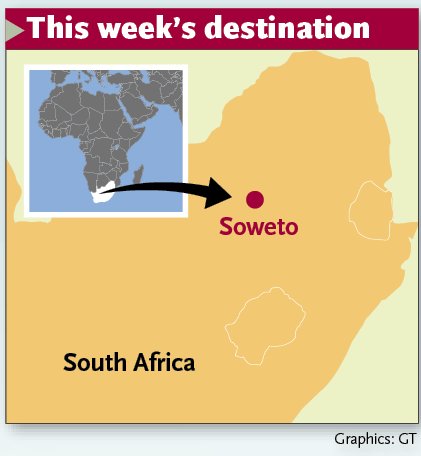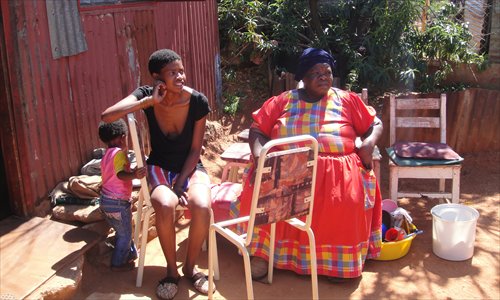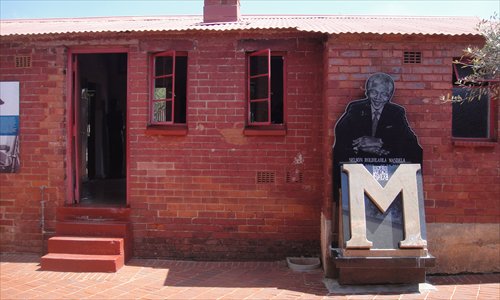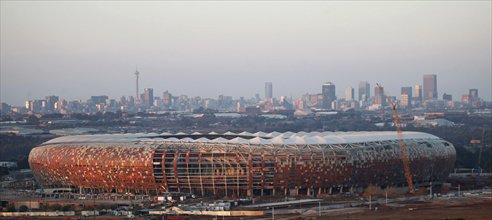Glimmers of light

This week's destination

Motsoaledi, a squatter camp in Soweto Photo: Wu Ningning/GT

Nelson Mandela's house in Soweto Photo: Wu Ningning/GT

The FNB Stadium, a South African icon during the 2010 FIFA World Cup, is seen under construction on the outskirts of Soweto in 2009. Photo: IC
Until last decade, Soweto was shrouded in darkness at night. The only street lights in the township were tall and huge, not used to illuminate the streets but to make it easier for apartheid-era police to control and spotlight agitators.
"I grew up in a Soweto that didn't have [regular] street lights," said our tour guide Morado, a 22-year-old local, "There is a power station right in Soweto's heart, but they didn't even provide power to the people of Soweto."
As I squinted in the direction he was pointing, I could see the Soweto Orlando towers, originally built for the Orlando Power Station, the most advanced facility of its day.
After the fall of apartheid in the 1990s and nearly two decades and a half of African National Congress (ANC) rule, Soweto is no longer as hungry for electricity as it once was, but the reminders of these years are dotted around everywhere .
The power station towers are one such reminder. Though dormant, painted in flamboyant murals and used as "one of the world's more incongruous bungee jumps," according to Lonely Planet, the towers still dominate people's memories.
Madiba's legacy
But the person who really led Soweto out of the darkness was late national hero Nelson Mandela.
Even today the image of "Madiba," an affectionate and respectful tribal name for Mandela, is everywhere from T-shirts to fridge magnets. His old house in Velekazi Street is the most popular stop for day-trippers.
Mandela actually spent little time there; it was his base only in the early 60s when he decided to abandon his former pacifism, went underground and founded the armed wing of the ANC, Umkhonto we Sizwe (Spear of the Nation). The interior contains a random collection of the great man's possessions such as doctorates, paintings, photos and furniture.
Down the road is the house of Mandela's close friend, social rights campaigner Archbishop Desmond Tutu, letting the street make the claim that it is "the only street in world to have housed two Nobel Peace Prize Winners."
Soweto is a dynamic town; the houses on Velekazi Street are vividly decorated and even the urinals are full of rainbows. Every house fights for attention, but Mandela's house is just plain red brick. Yet it stands out because it's unremarkable.
People flock to the house to honor Mandela's legacy. "But I do think people outside South Africa to arrive here to celebrate the man, rather than the country," said Tebogo, a local visitor.
He may be right. To some foreigners, Mandela was a miracle, an exceptional fluke that the country won't repeat. There are worries that after his death the country may head back into a spiral of racial division and political turmoil.
Soweto Uprising
But Mandela said many times that he wasn't the only inspirational fighter to emerge from the land. Many others fought for freedom in South Africa, or gave their lives to the country. Among the list of martyrs from Steve Biko to Chris Hani, Hector Pieterson should not be forgotten.
The 12-year-old boy was the first child to die under the police gunfire during the Soweto upsprings of 16 June, 1976 when over 500 students were killed as they protested over a decree issued by the apartheid government that imposed Afrikaans, which black students viewed as the "language of oppression," as the medium of instruction in black townships. The Hector Pieterson museum, two blocks from where the young boy was shot, was established in Soweto on June 16, 2002. Antoinette, Pieterson's sister, now works there as a tour guide.
Entering into the two-storey museum, the first thing you see is a picture that made world headlines in 1976. The image shows a bleeding Hector Pieterson, his face anguished, in the arms of 18-year-old schoolboy Mbuyisa Makhubo. Antoinette is running beside them crying desperately.
The wall of the museum is filled with pictures of marching children, holding banners and posters protesting the use of Afrikaans in schools. Text panels scattered throughout the museum give viewers accounts and backgrounds of the story of the uprising. One of the most tragically impressive showrooms is the Death Register that records the names of the children who died during the uprising.
Despite the horror, the Soweto Uprising sowed the seeds of freedom. Compulsory use of Afrikaans was abandoned, while the killings prompted thousands of students, of all races, to join the resistance to apartheid.
Outside the museum, the atmosphere is jubilant. Teenagers, the age of the students in the 1976 protest, happily posed for photographs. They may not understand what happened, but their eyes were filled with the hope their forefathers won for them.
Slums and screens
Signs of optimism can be seen everywhere in Soweto, in the gleaming shopping mall with an eight-screen cinema, in the Orlando stadium, a match venue for the 2010 World Cup, and even in the BMWs and Mercedes crawling in the frequent traffic jams. The township has demonstrated its capacity for reinvention.
But like most developing townships, there is no single face of modern Soweto. As our car drove to Motsoaledi, a squatter camp on the Old Potch Road, the last leg of the trip showed the township's continuing poverty.
We were led to the house of local resident Trudi, a brick two-bedroom shack with nine or ten people living in. Furniture was crammed into every corner.
With no electricity, no running water, the only source of income for the family is her grandmother's pension. The kids wear sandals because they have no shoes, and often go to bed hungry. Today, 20 years after liberalization, the days of carrying passbooks and of sitting in separate park benches had gone, but the poverty remains.
"So much has changed, but so much hasn't changed," said Trudi, 43, jobless, with four children, "In days of apartheid, life is uneasy, but we dreamed of better lives after we would be free. Now we remain as poor as under apartheid. The unemployment rate is 25 percent nationwide, but in Soweto, the rate is about 50 percent."
A new black elite has emerged since the 1990s, even as economic inequality has grown in recent years. Apartheid's night has passed, but it may be a long struggle till dawn.
Rules of thumb
Arrival: Most visitors take tours through travel agencies. You still can customize your tour by car through the suburbs. If driving, a local guide is handy. Alternatively, taking a Metrorail suburban train from Johannesburg Park station bound for Naledi (northern Soweto), Oberholzer (southern Soweto) is another good choice.
Security: Soweto is safer than many anticipate. But wherever you go with a tour group, or just travel alone, try to make sure you are accompanied by a local guide, especially going into a squatter camp like Motsoaledi. Local tour guides often secure and provide insight.